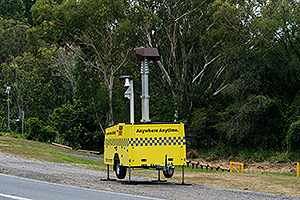Transportable speed cameras
Highly visible trailer mounted transportable speed cameras, also known as Transportable Road Safety Cameras, are operated by a service provider on behalf of the Department of Transport and Main Roads and deployed to high-risk areas, including highways and motorways, roadworks sites and school zones.
The only purpose of Transportable Road Safety Cameras is to reduce road trauma. Speed cameras deter motorists from speeding in the specific locations where they have been seen, as well as generally in the surrounding area and wider road network.
TRSCs are trailer mounted speed cameras enforcing the speed limit in both directions of travel. Speed enforcement in Queensland has been operating with a range of overt (marked) and covert (unmarked) vehicles and devices for decades.
More than half of Queensland speed related deaths are in regional and remote areas.
To combat this, you might see one of these big yellow boxes pop up in your area.
They are transportable speed cameras and they are lifesavers.
Here are a few more facts about them.
These cameras are placed to prevent crashes and are rotated regularly to keep people thinking about not speeding.
We select mobile speed cameras based on a strict criteria, with crash history being the primary reason.
The speed camera takes a second photo to ensure accuracy,
If you speed, you will be caught. Anywhere, anytime.
The fact is, speed cameras save lives.
Stick to the speed limit and keep our communities safe.
Calibration and accuracy
There are a number of checks done to ensure the accuracy of the speed cameras:
- First, the cameras have to be independently calibrated on an annual basis.
- When the trailer is setup, the speed of vehicles recorded from the trailer is reviewed by using a different speed camera device to ensure they are both measuring the same speeds. The trailer will not go into enforcement mode until after this verification.
- All offences detected are verified using a secondary verification method where two images of the vehicle taken are reviewed to check their speed, using time over distance calculations. Only offences supported by the secondary verification are sent for adjudication.
- The Queensland Revenue Office conduct an adjudication process before an offence is finalised and sent to a motorist.
To obtain a calibration certificate for a Transportable Road Safety Cameras or Roadways Behaviour Monitoring System, you can submit an enquiry to the Department of Transport and Main Roads. For more information about accessing calibration certificates, see the ‘Camera Accuracy and Calibration’ page.

Site selection and deployment
We select sites using strict criteria, including assessing speed-related crash history or potential crash risk.
Each site is assessed for suitability using strict criteria and approved by a Registered Professional Engineer of Queensland prior to being used. A site layout plan is developed for each site which must be adhered to by the service provider to ensure safety for all road users.
The cameras are rotated to a new site regularly throughout the Longreach base, Mackay base, Rockhampton base, Toowoomba base, Townsville base, Emerald base and Gympie base to establish general deterrence across the road network.
To deter theft and vandalism, the camera trailers have an extensive security and tracking system which monitors the camera trailer location 24 hours a day, 7 days a week. They are fitted with 360-degree CCTV cameras, audible alarm systems and live monitoring.
Infringements
Queensland Treasury is responsible for adjudicating and issuing infringements for offences detected by TRSCs. Specially trained officers conduct the adjudication process to produce highly accurate infringements. Infringements are only issued for motorists doing the wrong thing and putting themselves and other motorists at risk. The easiest way to avoid penalties is to obey the speed limit.
An infringement notice provides the registered operator with 28 days to either pay the fine, elect to go to court, or nominate the driver of the vehicle. Fines may be disputed by submitting an Election for Court or downloading and completing the form to dispute a fine in court for an individual (form F5111)
Money received from these fines are used to fund road safety programs including education and awareness and road improvements.